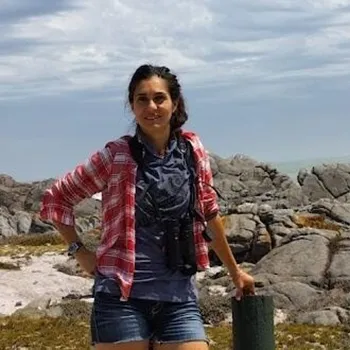Main Content
Marie-Sophie Garcia-Heras
Marie-Sophie Garcia-Heras, Assistant Professor
I am an avian ecologist and conservation biologist that specializes in the ecology and conservation of resident and migratory bird species, specially focused on raptors from around the world.
I am broadly interested in (1) developing comprehensive research projects that identify avian species’ needs and their associated biotic communities, (2) assessing how various environmental and anthropogenic stressors, worsened by climate change, may be altering species’ range and ecology throughout their life cycle, and (3) finding solutions to enhance long-term conservation of species and the ecosystems they depend on. My primary research interests focus on space-use and migration patterns, in addition to breeding ecology, diet, environmental toxicology, ecophysiology, and the interactions between top-predators and prey. I conduct interdisciplinary and multicultural research with local and international collaborators as key elements for a broader understanding of the ecology of wild species and the functioning of the ecosystems they depend on.
A few species I conduct research on include Egyptian Vultures in the Canary Islands, Black Harriers in South Africa, Pueo – Hawaiian Short-eared Owl – in Hawai‘i, Bald Eagles in Michigan, in addition to seabirds in the U.S. Pacific Coast (with Marbled Murrelets in Oregon).

445 Life Science II
garciaheras@siu.edu
Education
- B.A.: Université Paul‐Cézanne Aix‐Marseille III, France.
- MSc: Université Paul‐Cézanne Aix‐Marseille III, France.
- PhD: FitzPatrick Institute of African Ornithology, University of Cape Town, South Africa.
- Postdoctoral: Hawk Mountain Sanctuary, Oregon State University, and University of Hawai‘i at Mānoa.
Selected Publications:
Areas of Interests:
Raptor (Birds of Prey) Ecology and Conservation, movement ecology, breeding ecology, feeding ecology, environmental toxicology, eco-physiology, and interactions between top predators and prey.
Courses Taught:
- ZOOL 410 (Conservation Biology)
- ZOOL 467 (Ornithology)
- Colyn, R. B., -S. Garcia-Heras, R. E. Simmons, B. Arroyo, H. A. Smit-Robinson, C. W. Brink, M. A. Whitecross, and F. Mougeot (2025). Climate change modelling indicates extensive range contractions for a scarce southern African endemic and minimal protected area network within its future climatically suitable range. Ornithological Applications 127:duaf000.
- Garcia-Heras M.-S., Wolf C., Adrean L., Bailey Guerrero J., Nelson S.K., Roby D., Betts M., & Rivers J.W. 2024a. Spatio-temporal variation in marine space use of the endangered Marbled Murrelet (Brachyramphus marmoratus) in Oregon. Global ecology and Conservation, 50:e02857. https://doi.org/10.1016/j.gecco.2024.e02857. Impact Factor (IF): 4.0 in 2023.
- Garcia-Heras M.-S., Idle J.L., Harmon K.C., Wang O., Stormcrow K., Wilhite C.J., Naguwa W., Davidson L., Katayama L. & Price R.M. 2024b. Predation of the endangered Ae‘o (Hawaiian Stilt) by a native raptor, the Pueo (Hawaiian Short-eared Owl) on the island of O‘ahu, Hawai‘i, USA. Ecology and Evolution Nature Notes, 2024;14:e10844. DOI: 10.1002/ece3.10844. IF: 3.1 in 2021.
- Garcia-Heras M.-S. & Price R.M. 2024. First description of a double clutch, and inter-island movements of a Pueo (Hawaiian Short-eared Owl) in Hawai‘i, USA. Journal of Raptor Research 58(3):387–39. doi: 10.3356/JRR-23-66. IF: 1.7, in 2023.
- Betts M., Northrup J., Bailey Guerrero J., Adrean L., Nelson S. K., Fisher J., Gerber B., Garcia-Heras M.-S., Zhiqiang Y., Roby D., & Rivers J. 2020. Squeezed by a habitat split: warm ocean conditions and old-forest loss interact to reduce long-term occupancy of a threatened seabird. Conservation Letters, DOI: 10.1111/conl.12745. IF: 10.068, in 2022.
- Garcia-Heras M.-S., Arroyo B, Mougeot F, Bildstein K, Therrien J-F, & Simmons RE. 2019. Migratory patterns and settlement areas revealed by remote sensing in an endangered intra-African migrant, the Black Harrier (Circus maurus). PLoS ONE 14(1): e0210756. https://doi.org/10.1371/journal.pone.0210756. IF: 3.7, in 2022.
- Garcia-Heras M.-S., Arroyo B., Simmons R.E, Camarero P.R., Mateo R., & Mougeot F. 2018. Blood concentrations of PCBs and DDTs in an avian predator endemic to southern Africa: associations with habitat, density of electric transformers and diet. Environmental Pollution, 232:440-449. Doi:10.1016/j.envpol.2017.09.059. IF: 8.9, in 2023.
- Garcia-Heras M.-S., Arroyo B., Simmons R.E, Camarero P.R., Mateo R., Garcia J.T. & Mougeot F. 2017c. Pollutants and diet influence carotenoid levels and integument coloration in nestlings of an endangered raptor. Science of the Total Environment, 603-604: 299-307. Doi: 10.1016/j.scitotenv.2017.06.048. IF: 9.8, in 2023.
- Garcia-Heras M.-S., Mougeot F., Simmons R.E. & Arroyo B. 2017b. Regional and temporal variations in diet and provisioning rates suggest weather limits prey availability for an endangered avian predator. Ibis, 159: 567-579. Doi:10.1111/ibi.12478. IF: 2.517. in 2020.
- Garcia-Heras M.-S., Mougeot F., Arroyo B., Avery G., Avery M.D. & Simmons R.E. 2017a. Is the Black Harrier Circus maurus a specialist predator? Assessing the diet of a threatened raptor species endemic to southern Africa. Ostrich: Journal of African Ornithology, 2017: 1-8. Doi: 10.2989/00306525.2016.1257515. IF: 0.833, in 2016.
- Garcia-Heras M.-S., Arroyo B., Mougeot F., Amar A. & Simmons R.E. 2016. Does timing of breeding matter less where the grass is greener? Seasonal declines in breeding performance differ between regions in an endangered endemic raptor. Nature Conservation, 15: 23-45. Doi:10.3897/natureconservation.15.9800. IF: 1.519, in 2020.
- Garcia-Heras M.-S., Cortés-Avizanda A. & Donázar J.A. 2013. Who are we feeding? Asymmetric individual use of surplus food resources in an insular population of the endangered Egyptian vulture Neophron percnopteruPlosONE 8(11): e80523. IF: 3.7, in 2022.



